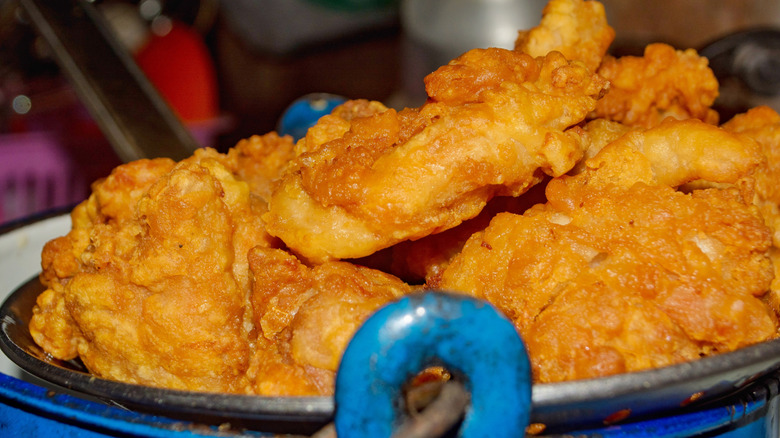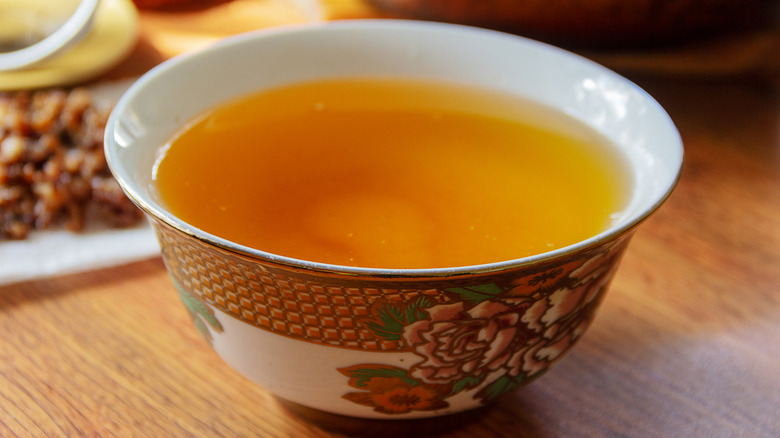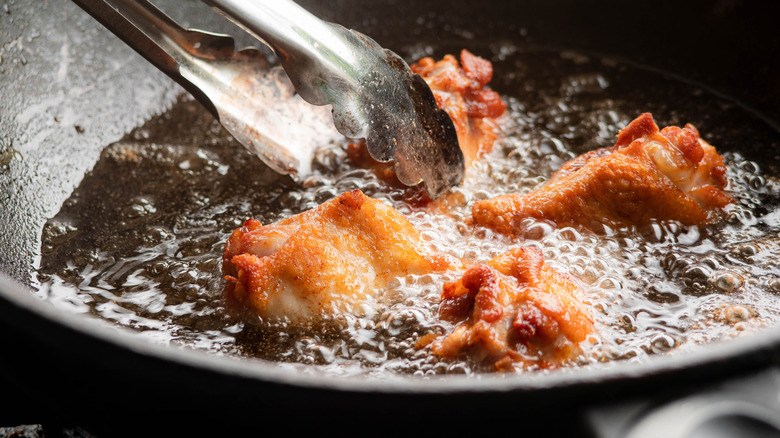The Underrated Fat That Makes For Unbeatable Fried Chicken
We may receive a commission on purchases made from links.
Some fried chicken recipes call for frying in vegetable oil, some use shortening instead. Chef Matt Abdoo, however, proposes a third option: He likes to use lard, which is appropriate considering the restaurant chain he runs is called Pig Beach BBQ. He tells The Takeout, "Frying in lard adds an amazing rich porky flavor to anything that you fry in it. It's nearly impossible to replicate that flavor with vegetable oils or even peanut oil."
One thing you need to know before you reach for the pig fat is that, for deep frying purposes, it's essential to use rendered or refined lard. Not only does Abdoo insist that this type of lard has a better flavor than leaf lard, which is the kind typically used in baking, but more importantly, it has a higher smoke point. Leaf lard has a smoke point of around 370 degrees Fahrenheit, which is too low for deep frying. It's best to use an oil with a smoke point at least 50 degrees above the cooking temperature, and fried chicken recipes can call for oil to be heated up to 375 degrees. Refined lard, however, has a smoke point as high as 425 degrees Fahrenheit, making it suitable for deep frying.
How to reuse lard for frying
Leaf lard may not be too pricey, as it could cost just a couple of bucks per pound, but refined lard may be more expensive — a 1-pound tub of Goya refined lard is currently selling for $12.49 on Amazon, and this is about as much as you'll need to fry a batch of chicken. Luckily, it's okay to reuse lard for frying, just as you might reuse frying oil. According to Matt Abdoo, "There are no real significant differences in the process of frying with lard vs vegetable oil," although he adds a disclaimer: "Downsides is that lard can become rancid quicker than vegetable oil [and] it can hold flavors of the previous item that was fried in it more." For this reason, he cautions against frying chicken in lard that was previously used to fry fish. If you last used it for french fries, however, you should be okay.
As with any cooking fat, you can't reuse lard indefinitely, but only until it starts to go off. "Generally speaking," says Abdoo, "you should be able to get at least two fries out of a batch of lard." You might even be able to stretch it for more, as long as you haven't let it get too hot and you've strained and stored it as soon as you're done frying. The way to tell if lard can be reused is if it's still translucent when melted and it also smells okay. If it turns black and smells either burnt or rancid, it's done.
These other fats can be used to fry chicken
Lard isn't the only animal fat that can be used for frying. Tallow, which differs from lard in that it comes from a cow instead of a pig, has a smoke point of 400 degrees Fahrenheit, so it's good for frying chicken at temperatures up to 350 degrees Fahrenheit. Lower smoke point aside, Matt Abdoo asks, "The real question is, do you want that slightly sweet porky flavor added to what you're frying in, or that rich beefy umami flavor?"
Abdoo offers another suggestion as well, telling us, "Duck fat is also really great as it gives an incredible flavor." The problem with duck fat is that it, like chicken fat, has a smoke point of 375 degrees Fahrenheit, making it a medium rather than high smoke point fat. While these types of fat are generally considered to be better for pan frying, you should be able to use either duck fat or schmaltz for frying chicken at temperatures up to 325 degrees Fahrenheit. (Luckily, some recipes do call for this lower-heat method.)
Abdoo also likes to use clarified butter, aka ghee, as it has a much higher smoke point than regular butter. This type of butter, which has been melted and strained to remove the water and milk solids, can be heated up to 450 degrees Fahrenheit. Regular butter, on the other hand, taps out at 300 to 350 degrees Fahrenheit, making it best suited to sauteing.


